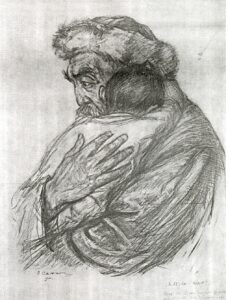ASTANA – This year, Kazakhstan is celebrating 200 years of Kurmangazy Sagyrbayuly, a leading figure in Kazakh traditional music, composer, and versatile dombra performer, whose music reflected personal narratives and stories of Kazakh people in the 19th century.
 Kurmangazy spoke to the hearts of less privileged Kazakh people, fighting against injustice and the unaccountability of the rich. His music echoed his history and culture and helped heal the deeply wounded society of the 19th century. He was universally loved by Kazakhs for this.
Kurmangazy spoke to the hearts of less privileged Kazakh people, fighting against injustice and the unaccountability of the rich. His music echoed his history and culture and helped heal the deeply wounded society of the 19th century. He was universally loved by Kazakhs for this.
Kurmangazy, the son of Sagyrbay, was born in 1823 in the Bukey Horde, now a district of Zhanakala in the West Kazakhstan Region. His mother Alka encouraged him to play dombra when his musical talents became apparent.
At age six, Kurmangazy began to help out with shepherding. Being a shepherd in his native auyl (village), Kurmangazy was exposed to many folk melodies performed by visiting kuishis (traditional music performers). One of them was a kuishi named Uzak, who became his first teacher. Uzak had a sharp eye for the young boy’s talent and predicted great potential.

Graphic artist and painter Sakhi Romanov created a series of 15 graphic drawings called “Life and Creativity of Kurmangazy” each representing the composer’s kuis. This drawing represents “Oh, my son Kazi!” kui. Photo credit: culture-art.ru.
This period coincided with a wave of national revolt in the Bukey Horde under the leadership of Issatay Taimanuly and Makhambet Utemisuly in 1836-1838 due to pastures being taken away from Kazakhs.
“Kishkentai” (Small) kui (traditional musical composition) was dedicated to Taimanuly. The kui symbolized the struggles Kazakhs endured during colonization and questioned the legacy of Russian Tsarist policies.
By the age of 18, Kurmangazy left his native auyl, and started a life of a wandering kuishi. He participated in competitions with Uzak, developed his skills, and was admired by many for his talent.
His music materialized from observing the people’s desire for freedom and the struggle against injustice. The works depict socio-psychological circumstances of the relationship between man and society.
Kurmangazy was persecuted for his open criticism of the rich. He was repeatedly imprisoned in Uralsk, Orenburg, and Omsk.
Life in prison greatly influenced Kurmangazy’s music. He wrote several kuis, including “Kairan Sheshem” (“Oh, my sweet Mother”), “Turmeden Kashkan” (“Escape from Prison”), “Aman bol, Sheshem, Aman bol!” (“Goodbye, Mother, Goodbye!”), and “Yerten Ketem” (“I am Leaving Tomorrow”), which embody the feeling of nostalgia, the pain of leaving, and the longing for family and freedom.

Drawing of “Oh, my sweet Mother” kui by Sakhi Romanov. Photo credit: culture-art.ru
He also composed “Alatau” and “Saryarka” of a more rebellious character, in which he conveyed the vastness of the Kazakh steppes and his thoughts about the independence and freedom of the people.
The famous “Adai” kui at its core carries an unbreakable spirit and energy – an important counterweight to the mood of people caught up in the midst of the power struggles of the wealthy.
A journalist and poet from Uralsk Nikita Savichev, who met Kurmangazy in 1868, wrote in the Uralskiye Voyskovye Vedomosti newspaper that Kurmangazy is a “rare musical soul.”
“If he had a European education, he would have been a star of the first magnitude in the world of music,” wrote Savichev, adding that he was fascinated by Kurmangazy’s virtuoso playing ability on the dombra.
In 1880, Kurmangazy settled in the town of Sakhma near Astrakhan in Russia. He spent the last years of his life gathering artists and passing his mastery to them. Kurmangazy contributed to the emergence of great composers, including Dina Nurpeisova, Yergali Eszhanov, Mamen, and widely known dombra players such as Kokbala, Menetai, Menkara, Sugurali, Torgaibay, and Shora.

First President Nursultan Nazarbayev attended the opening of Kurmangazy’s mausoleum in Altynzhar village in the Astrakhan Region in 1996, on the eve of the 100th anniversary of the great composer’s death. Photo credit: presidentlib.kz
Kurmangazy died in 1896 and was buried in the village of Altynzhar of today’s Volodarsky district of the Astrakhan Region.
Among the people who retrieved Kurmangazy’s music from obscurity and enabled it to reach the present audience was academician and composer Akhmet Zhubanov, who later became the chief conductor of the National Folk Instruments Orchestra named after Kurmangazy. He published two collections of kuis that preserved the notes and their background history.
The scope of over 60 kuis reveals the breadth of Kurmangazy’s fascination with traditional Kazakh music.

